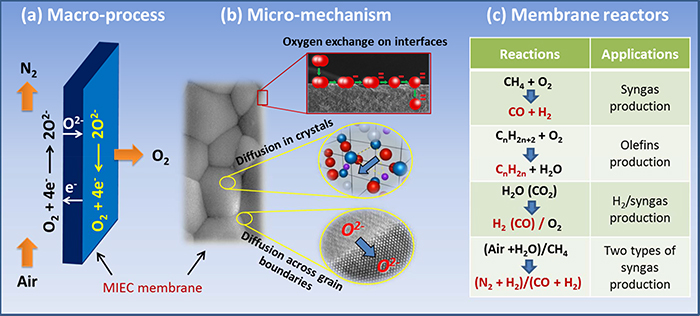A research group led by Prof. YANG Weishen reviewed the recent advances of oxygen permeable membranes. And the report was published in Advanced Materials.

a) Macroprocess of oxygen permeation. b) Micromechanism of oxygen exchange on the gas–solid interfaces, oxygen transport in the crystals and across the grain boundaries of a MIEC membrane. c) The reaction–separation coupling in MIEC membrane reactors. (Image by ZHU Xuefeng)
Oxygen permeable membranes, made of mixed conducting ceramics, can produce high-purity oxygen with high energy efficiency and low investment cost than the cryogenic distillation technology.
The oxygen permeable membrane technology has great application prospect in many important industrial processes, such as chemical industries, clean power generation, ferrous metallurgy, glass making, environmental protection and medical cares. Except for oxygen separation, oxygen-permeable membranes can be used as membrane reactor for reaction-separation coupling to significantly simplify the technological scheme and reduce the process energy consumption.
The scientists reviewed the recent advances in the development of oxygen permeation models that provided a deep understanding of the microstructural and interfacial effects, and discussed strategies to simultaneously improve the permeability and stability through microstructural and interfacial design in detail.
Then, based on the developed high-performance membranes, they highlighted the highly effective membrane reactors for process intensification and new technology developments. The new membrane reactors would trigger innovations in natural gas conversion, ammonia synthesis and hydrogen-related clean energy technologies.
Future opportunities and challenges in the development of oxygen-permeable membranes for oxygen separation and reaction-separation coupling were also explored.
This work was supported by the National Natural Science Foundation of China, the Strategic Priority Research Program of the Chinese Academy of Science, etc. It was dedicated to the 70th anniversary of DICP, CAS. (Text by ZHU Xuefeng)